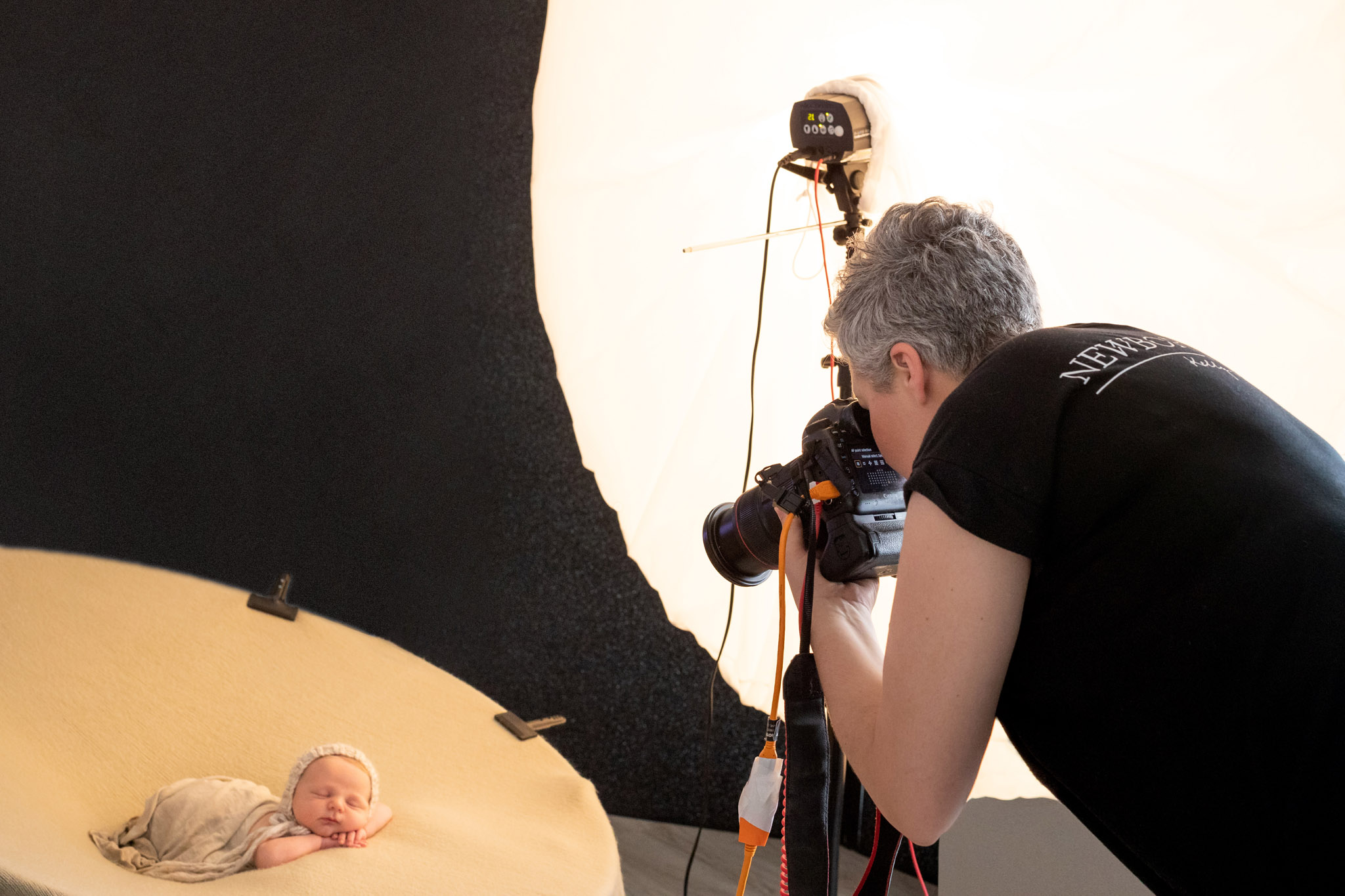In her Newborn Photography Lighting online class, Kelly Brown demonstrates how she controls natural daylight, continuous light, and studio strobe light, to create her newborn and family portraits.
In the strobe lighting tutorials, Kelly uses a “monolight” style of studio flash. In a monolight, the lamp and power supply are contained within the head. This differs from “floor pack” studio lights which you may also come across, in which the lamp head and the power-pack (which sits on the floor) are separate units. We find monolights to be more practical and portable for domestic studio photography, particularly in smaller spaces.

WHAT IS A STUDIO STROBE LIGHT?
A studio strobe light emits a short, powerful flash of light when triggered.
Studio flash output is measured in watts per second. In the Newborn Lighting class, Kelly uses an Elinchrom RX One strobe, which features 100Ws maximum output. Importantly, it is variable down to 6Ws at its lowest output. This makes it very versatile, especially for those with limited space to position lights.

Most strobes are compatible with many accessories including softboxes and umbrellas for shaping your light, and, depending on the model, wireless triggers for firing and controlling your output settings.
Because the light only fires for a fraction of a second – around 1/2000th sec or faster depending on your model – most studio strobes come with a second light, referred to as a modelling lamp.
WHAT IS A MODELLING LAMP?
A modelling lamp is a continuous light located very close to the flash tube. Its purpose is to assist the photographer to see where the strobe light will fall when fired. Using the modelling lamp as a guide will help you set the position and angle of the strobe and its modifier (eg. softbox). When buying, we recommend purchasing a strobe which includes a modelling lamp.
The modelling lamp is often a tungsten light source, and so will appear warmer than the daylight-balanced strobe output. However this is not a concern as the modelling lamp will turn off temporarily while the flash fires.
TIP: When you first begin working with studio strobes, make yourself familiar with the product guide. Learn how to control the brightness of the modelling lamp independently of the flash output. We regularly hear from new photographers who are initially unaware that there is a separate control for each output, depending how well marked they are on the units.
NEW TO STROBE LIGHTING?
In this class, Kelly walks you through light placement and angle, as well as demonstrating how she achieves correct exposure using both the strobe’s settings and her camera’s settings.

EQUIPMENT USED IN THE NEWBORN STROBE LIGHTING VIDEOS
STROBE
In her Newborn Photography Lighting class, Kelly uses an Elinchrom D-Lite RX One strobe, which has a power range from 100 Ws to 6 Ws. While this is not a very high maximum output compared with other lights on the market, you will see in the tutorials that it is perfect for the job as Kelly photographs a newborn on posing bag and in prop, as well as a group of 5 siblings.
If you are starting out, the Elinchrom D-Lite RX One is a great light to begin with, remembering you can always add another light of a higher output to your kit, later on.
NEW ELINCHROM STROBE!
In 2020, Elinchrom released the new mid-range ELC 125 studio flash, with an output range of 131WS down to 9WS, similar to the RX One mentioned above. Kelly used the Elinchrom ELC 125 to capture the couple poses in her Maternity Posing tutorials.

LIGHT SHAPING TOOLS
Kelly pairs the RX One strobe with a 5.5 foot diffused umbrella. She would also recommend any standard large (4.5 to 6 foot) octagonal soft box to help you create soft diffused light, while controlling your shadows to give your subject depth.
When purchasing modifiers such as softboxes and beauty dishes, remember that your studio flash has a unique mount specific to its brand. eg. Bowens, Elinchrom, Broncolor, etc. A modifier must have the same mount to attach to your light. Most umbrellas, on the other hand, will simply slip into the generic umbrella mount, but be sure to double check before purchase.
(Also see Tips for Continuous Lighting for more tips.)
CHOOSING A STUDIO STROBE LIGHT
- Consider portability if you are a location photographer
- When considering budget, take into account that you may want to invest in more than one strobe down the track, if you’re interested in experimenting with lighting
- For convenience, look for a model which allows the flash output to be controlled remotely by trigger, as well as manually through the back of the strobe unit
REMOVE PROTECTIVE CAP TO AVOID MELTING – OR WORSE
SAFETY TIP!
Most strobes have a protective cover over the flash tube and modelling lamp.
YOU MUST REMOVE THE PROTECTIVE CAP BEFORE TURNING YOUR LIGHTS ON.
Failure to do so will cause the cover to melt, and potentially worse. Remember light – both modelling lamp and flash tube – generates heat. The cap is a safety feature to protect the glass tube/bulb from damage and wear, but always remove before turning the power on.


Naila Rahim says
Kelly, you are my photography GURU ! Your team is also amazing. Thank you for sharing your knowledge with us.
Frank kamukwamba says
You are doing a very fine work… thumbs up
Sandra says
Thank you Kelly. I am a photography beginner and have to learn so much about Lightning. Your Tutorials are super good for me.